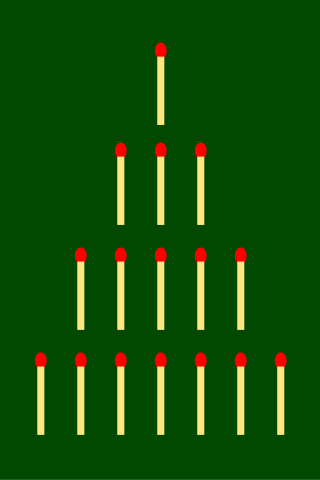
Nim is a mathematical game of strategy in which two players take turns removing objects from distinct heaps or piles. On each turn, a player must remove at least one object, and may remove any number of objects provided they all come from the same heap or pile. Depending on the version being played, the goal of the game is either to avoid taking the last object or to take the last object.
In combinatorial game theory, the Sprague–Grundy theorem states that every impartial game under the normal play convention is equivalent to a one-heap game of nim, or to an infinite generalization of nim. It can therefore be represented as a natural number, the size of the heap in its equivalent game of nim, as an ordinal number in the infinite generalization, or alternatively as a nimber, the value of that one-heap game in an algebraic system whose addition operation combines multiple heaps to form a single equivalent heap in nim.
In mathematics and computing, Fibonacci coding is a universal code which encodes positive integers into binary code words. It is one example of representations of integers based on Fibonacci numbers. Each code word ends with "11" and contains no other instances of "11" before the end.
In combinatorial game theory, an impartial game is a game in which the allowable moves depend only on the position and not on which of the two players is currently moving, and where the payoffs are symmetric. In other words, the only difference between player 1 and player 2 is that player 1 goes first. The game is played until a terminal position is reached. A terminal position is one from which no moves are possible. Then one of the players is declared the winner and the other the loser. Furthermore, impartial games are played with perfect information and no chance moves, meaning all information about the game and operations for both players are visible to both players.
In mathematics, the nimbers, also called Grundy numbers, are introduced in combinatorial game theory, where they are defined as the values of heaps in the game Nim. The nimbers are the ordinal numbers endowed with nimber addition and nimber multiplication, which are distinct from ordinal addition and ordinal multiplication.
21 (twenty-one) is the natural number following 20 and preceding 22.

Combinatorial game theory is a branch of mathematics and theoretical computer science that typically studies sequential games with perfect information. Study has been largely confined to two-player games that have a position that the players take turns changing in defined ways or moves to achieve a defined winning condition. Combinatorial game theory has not traditionally studied games of chance or those that use imperfect or incomplete information, favoring games that offer perfect information in which the state of the game and the set of available moves is always known by both players. However, as mathematical techniques advance, the types of game that can be mathematically analyzed expands, thus the boundaries of the field are ever changing. Scholars will generally define what they mean by a "game" at the beginning of a paper, and these definitions often vary as they are specific to the game being analyzed and are not meant to represent the entire scope of the field.
In combinatorial game theory, star, written as or , is the value given to the game where both players have only the option of moving to the zero game. Star may also be denoted as the surreal form {0|0}. This game is an unconditional first-player win.

Chomp is a two-player strategy game played on a rectangular grid made up of smaller square cells, which can be thought of as the blocks of a chocolate bar. The players take it in turns to choose one block and "eat it", together with those that are below it and to its right. The top left block is "poisoned" and the player who eats this loses.

In mathematics, Zeckendorf's theorem, named after Belgian amateur mathematician Edouard Zeckendorf, is a theorem about the representation of integers as sums of Fibonacci numbers.

Hackenbush is a two-player game invented by mathematician John Horton Conway. It may be played on any configuration of colored line segments connected to one another by their endpoints and to a "ground" line.
In mathematics, the mex of a subset of a well-ordered set is the smallest value from the whole set that does not belong to the subset. That is, it is the minimum value of the complement set.

Wythoff's game is a two-player mathematical subtraction game, played with two piles of counters. Players take turns removing counters from one or both piles; when removing counters from both piles, the numbers of counters removed from each pile must be equal. The game ends when one player removes the last counter or counters, thus winning.
In mathematics, negafibonacci coding is a universal code which encodes nonzero integers into binary code words. It is similar to Fibonacci coding, except that it allows both positive and negative integers to be represented. All codes end with "11" and have no "11" before the end.
Subtract-a-square is a two-player mathematical subtraction game. It is played by two people with a pile of coins between them. The players take turns removing coins from the pile, always removing a non-zero square number of coins. The game is usually played as a normal play game, which means that the player who removes the last coin wins. It is an impartial game, meaning that the set of moves available from any position does not depend on whose turn it is. Solomon W. Golomb credits the invention of this game to Richard A. Epstein.

Kayles is a simple impartial game in combinatorial game theory, invented by Henry Dudeney in 1908. Given a row of imagined bowling pins, players take turns to knock out either one pin, or two adjacent pins, until all the pins are gone. Using the notation of octal games, Kayles is denoted 0.77.
In mathematics, a sequence of natural numbers is called a complete sequence if every positive integer can be expressed as a sum of values in the sequence, using each value at most once.
In mathematics, the Wythoff array is an infinite matrix of integers derived from the Fibonacci sequence and named after Dutch mathematician Willem Abraham Wythoff. Every positive integer occurs exactly once in the array, and every integer sequence defined by the Fibonacci recurrence can be derived by shifting a row of the array.
In combinatorial game theory, a subtraction game is an abstract strategy game whose state can be represented by a natural number or vector of numbers and in which the allowed moves reduce these numbers. Often, the moves of the game allow any number to be reduced by subtracting a value from a specified subtraction set, and different subtraction games vary in their subtraction sets. These games also vary in whether the last player to move wins or loses. Another winning convention that has also been used is that a player who moves to a position with all numbers zero wins, but that any other position with no moves possible is a draw.
In mathematics, the fibbinary numbers are the numbers whose binary representation does not contain two consecutive ones. That is, they are sums of distinct and non-consecutive powers of two.








